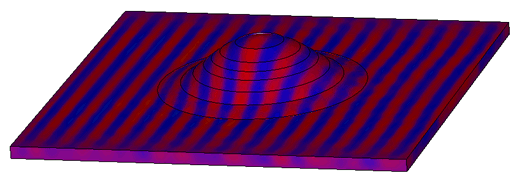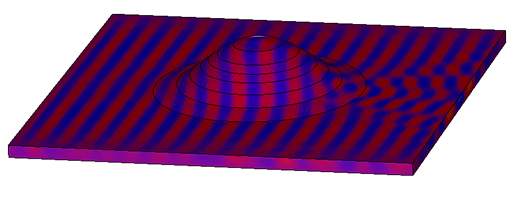 Menu
Menu
Perfect Surface Wave Cloaks
A new technique that allows curved surfaces to appear flat to electromagnetic waves has been developed by QUEST researchers from QMUL and Exeter, in work published in the journal Physical Review Letters.
The discovery could hail a step-change in how antennas are tailored to each platform, which could be useful to a number of industries that rely on high performance antennas for reliable and efficient wireless communications. The underlying theory developed in this study has had a wide impact on the antennas and aerospace industry, in which UK has strong presence internationally.
The researchers coated a curved surface with a medium where the refractive index – a measure of how light passes through substances – varies depending on the position of the wave. Although the coating is only a fraction of a wavelength thick, it can make the curvature appear invisible to surface waves, even for objects large in terms of the wavelength.
A surface wave is a wave that is confined to a surface, usually an interface between two materials. This makes it a two-dimensional wave to all practical intent, rather than travelling in three dimensional space. The QUEST researchers have shown that it is possible to achieve perfect cloaking of deformations in a surface by controlling the properties of the dielectric medium the surface wave propagates along. This can be important if the deformation would otherwise prevent the surface wave from propagating to a particular part of the surface. It also means that the coating can be used as a cloak, because the space created underneath the bumpy surface can shelter an object that would ordinarily have caused the wave to be scattered.
Unlike other approaches to 2D and 3D cloaking, this method does not require extreme material property values, anisotropy (where material properties are different depending on what direction the wave takes through the material) or metamaterials, articificial materials that often have narrow operating bandwidths. Furthermore, these cloaks are not restricted to one polarisation, unlike other methods. Quoting from the paper: "These cloaks could be applied to the design of conformal surface wave-based antenna devices which are retrofitted to vehicles or airborne platforms, where perturbations of the surface are necessary for structural or aerodynamic reasons, but create scattering of the surface waves which is detrimental to their performance."
The animations below demonstrate the effect of the bump with and without the cloak. In the first animation, it is clear that the wavefronts (the red and blue lines) remain parallel as the pass over the bump and no interference pattern is visible. However, in the second, the wavefronts become curved as they cross the bump and an interference pattern is generated as the wave exits the bump on the right hand side.


The top figure shows the cloak in action, and the bottom figure shows what happens when the cloak design is not used. Plane electromagnetic surface waves are incident from the left and are scattered by the bump, but the cloak is able to remove the scattering, and the waves are the same shape after propagating across the bump.
Professor of Antennas and Electromagnetics and study lead Yang Hao, said: “The design is based upon transformation optics, a concept behind the idea of the invisibility cloak. While perfect cloaking is yet to be demonstrated in free space, we have proved that it is possible for surface waves.”
More information can also be found in the related press release.
